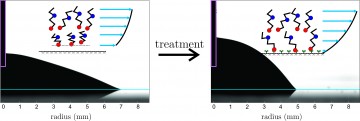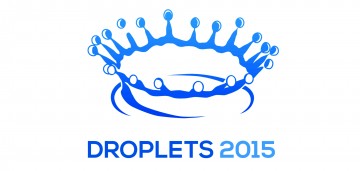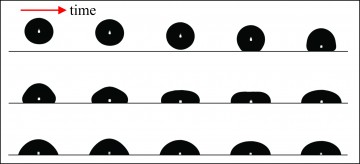Evaporation test -UC
Blog
Paper on Slip: read on Langmuir
By mazi on November 20, 2015

Our paper on slip of complex droplets on smooth surfaces is online. Check it out here. Feel free to contact me if you do not have access to the full text.
Abstract:
The spreading of axisymmetric viscoplastic droplets extruded slowly on glass surfaces is studied experimentally using shadowgraphy and swept-field confocal microscopy. The microscopy furnishes vertical profiles of the radial velocity using particle image velocimetry (PIV) with neutrally buoyant tracers seeded in the fluid. Experiments were conducted for two complex fluids: aqueous solutions of Carbopol and xanthan gum. On untreated glass surfaces, PIV demonstrates that both fluids experience a significant amount of effective slip. The experiments were repeated on glass that had been treated to feature positive surface charges, thereby promoting adhesion between the negatively charged polymeric constituents of the fluids and the glass surface. The Carbopol and xanthan gum droplets spread more slowly on the treated surface and to a smaller radial distance. PIV demonstrated that this reduced spreading was associated with a substantial reduction in slip. For Carbopol, the effective slip could be eliminated entirely to within the precision of the PIV measurements; the reduction in slip was less effective for xanthan gum, with a weak slip velocity remaining noticeable.
Viscoplastic Fluids: From Theory to Application in Banff
By mazi on September 28, 2015

10th anniversary of Viscoplastic Fluids workshop will be held in Banff this year. The meeting will focus on severalk topics such as thixotropy, shear-banding, multiphase and multi-fluid flows, bubbles, drops & particles, onset of motion and stability, computational methods, exotic fluids, thermally sensitive fluids etc.
I will present a talk titled: “Thermo-responsive polymeric solutions: from rheology to applications”
more information here.
APS-DFD, this November at Boston
By mazi on September 28, 2015

APS DFD 68 will be held at Boston this year. I will also give a talk on spreading of complex droplets. Here is the abstract:
The spreading of yield stress liquid droplets on a dry surface occurs in a number of applications such as 3D printing. In the current study, the surface-tension-driven spreading of a yield-stress (Bingham) droplet on a solid wetting surface is studied. Neglecting gravity and using lubrication theory for viscoplastic fluids, we derived the thin film equation in 2D. Equations were solved numerically, where to avoid the moving contact line singularity, we used a pre-wetted film. Numerical solutions show the decelerating spreading of the droplet and its arrest due to the yield stress. Additionally, the final shape of the droplets was constructed, using an asymptotic method. Results were compared with the numerical solutions, where agreements were observed.
Droplet 2015, a great idea!
By mazi on September 28, 2015

Droplet 2015 will be held this Octoeber in Enschede (the Netherlands). This is a relatively small workshop/conference that brings together the people who work on droplets.
Michael Brenner of Harvard, Emmanuel Villermaux of Aix Marseille University and so many others are talking droplets.
I will also talk about one of my projects on spreading of complex droplets titled: “Thermal Arrest of Droplets”.
I will update this post when the workshop started. Also follow my twitter for more updates.
Smart Impact
By Regie Sacdalan on March 4, 2013
My first paper on controlled impact of droplets has been published in Soft Matter. Do not hesitate to contact me if you want a copy. Here is the abstract:
A novel methodology for controlling the spreading of droplets impacting a substrate is presented. The working fluid is a thermo-responsive polymer solution that undergoes a sol–gel transition above a specific temperature. It is shown that the maximum diameter of a droplet at equilibrium can be controlled through the substrate temperature of the substrate and the polymer concentration.
